Things That Matter: the State of the (Dis-)Union

In a recent webinar on the Things That Matter, polls of attendees revealed low confidence, fragmented focus, and many issues on the ground. Whilst expected, it’s a stark reminder of the state of disunion when it comes to what matters. Something needs to be done.
Last week, I introduced the Things That Matter concept to WorldCC members as part of their Thought Leadership webinar series.
Titled Things That Matter: define, measure, manage and transform high-value relationships, the webinar asked “How can your commercial relationships succeed when the ‘Things That Matter’ aren’t clear and aligned?”:
- I explained how the Things That Matter are the components or “elements” of Value – critical to outcomes and increasingly subjective – but that there are all kinds of issues with them on the ground: people aren’t clear or aligned on them, and this is especially true in relationships.
- I set out the surrounding context – the unprecedented Complexity we’re experiencing – and explained how, despite being crucial, relationships aren’t working: primarily due to how existing top-down approaches aren’t fit for purpose.
- I outlined our Three Step Process as the necessary alternative, and talked about why it works, including some of its practical benefits.
Along the way, there were three polls of the webinar attendees, and whilst these were only done quickly (and with a relatively small group), the findings indicate what we’ve been saying for some time now in terms of the struggles in relationships.
Because what we saw was the state of the (dis-)union when it comes to the Things That Matter: low confidence levels, fragmented focus, and issues on the ground – all likely to compromise effectiveness and outcomes.
Poll 1: Low Confidence Levels
Right at the outset – before explaining in more depth what we meant by “Things That Matter” – I asked attendees “How confident are you that those involved in your commercial relationships are clear and aligned on the Things That Matter?“.
There were two broad aims here:
- Get people in the mindset of thinking about what matters and how clear and aligned that is at present.
- Demonstrate that the “Things That Matter” phrase intuitively makes sense (a point I would come back to later in the webinar) – people can engage without more explanation (even if such explanation obviously adds further understanding).
We generally find that people either aren’t that confident when “challenged”, or that initial confidence wanes when we go into more depth, and I think you’ll agree that the former was very much the case here:
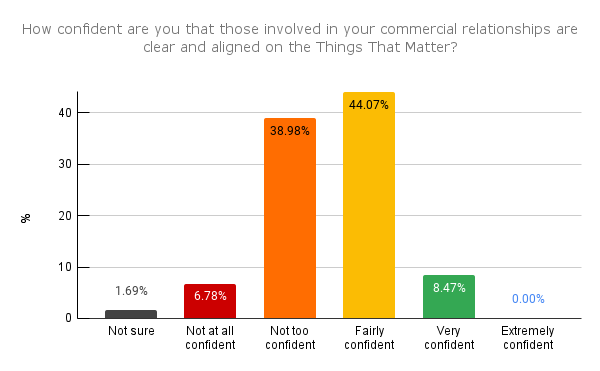
Only 1.69% of attendees answered “not sure”, and whilst that could indicate that they weren’t sure what “Things That Matter” meant, it’s at least as likely they were saying they just didn’t know their confidence levels.
Either way, the concept of Things That Matter indeed proved to be intuitive in establishing engagement, and the other main headlines are equally clear:
- Not even 10% of attendees were “very confident” that those involved in their relationships are “clear and aligned” on the Things That Matter.
- Of the remaining ~90%, only half were “fairly confident”, with the rest “not too confident” or “not at all confident”.
Now, to be absolutely clear, this in no way reflects poorly on webinar attendees.
Quite the opposite, in fact, because they were extremely honest (the anonymous poll format may have helped), and because what they said is typical of what we see everywhere (and certainly typical of what we say throughout the material on this site).
But it’s one thing for us to say that this is the case – with all the negative impacts it has on relationships and outcomes – and quite another to see it said back to us.
How, indeed, can “commercial relationships succeed when the ‘Things That Matter‘ aren’t clear and aligned?“!
But there’s more.
Poll 2: Fragmented Focus
The second poll came in after I’d explained in more detail what Things That Matter are
- I’d said how – in being the components or elements of Value – we were talking about Value in its widest possible sense (not just price and cost), and so Things That Matter not only cover every kind of goal, but also issues, ideas, risks, principles, values and so on.
- I’d also explained (with examples) how Things That Matter occupy the ground between abstract and actionable – recognizably about something, but more than just a single, clear action – how they’re typically cross-boundary, how they change over time, and (most of all) how they’re significantly or wholly subjective, involving judgments, perceptions and intangibles.
With that context set, I asked “How and where are the Things That Matter to your organization currently articulated and communicated (choose as many as apply)?” – again with multiple aims:
- For attendees to consider what they were currently doing (as I was about to share our findings on the state of relationships).
- To see if there was any consensus on which methods were used.
- To see if (as I expected) attendees would indicate that the Things That Matter were being dispersed across several places.
Again, I think you’ll see that the findings were striking, with no one method dominant:
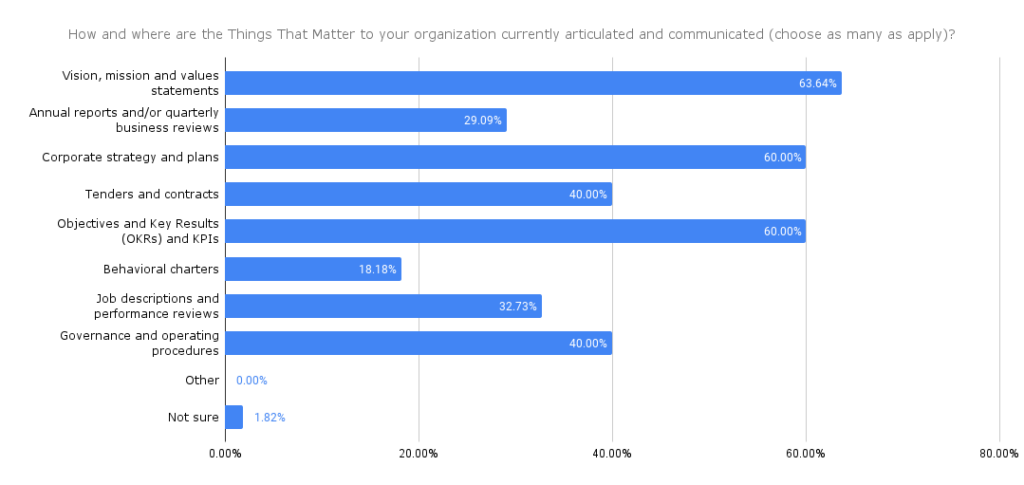
My co-hosts on the webinar were immediately drawn to the fact that only 40% of attendees felt that tenders and contracts articulate and communicate what matters to their organizations – these are the principal instruments for establishing relationships, after all! – and it was also striking how skewed towards more objective Things That Matter the main methods in use are:
- Fewer than 20% reported behavioral charters being used – i.e. the one source on the list purely for “softer” Things That Matter.
- As expected, OKRs and KPIs were pretty much on top – familiar territory for harder data, objective measures, managed risks, etc.
- Whilst over 60% said that “Vision, mission and values statements” are in use, at least some of these are going to cover more “objective” factors, and it would be reasonable to ask how helpful these high-level instruments are in guiding day-to-day activity.
But even if – with more probing – we were to find that subjective Things That Matter are getting more of a look-in than it initially seems, almost 2/3 of attendees (63.64%) said that the Things That Matter are spread across three or more places:
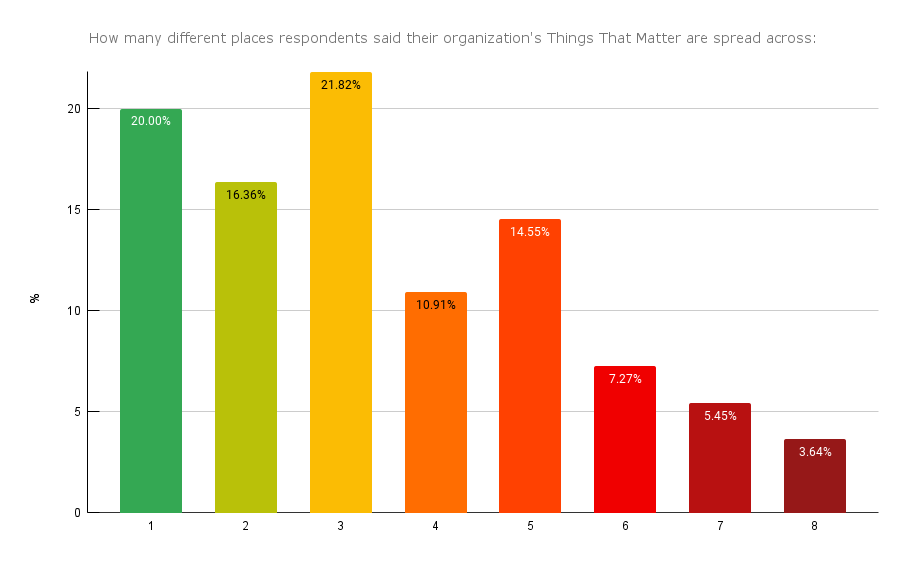
(And because the options in the poll were all so different in their nature and focus, this almost certainly doesn’t reflect a consistent set of Things That Matter permeating several sources – rather, it indicates that the Things That Matter are being dispersed. Which is what I expected.)
At this point – with focus so fragmented – how are people supposed to quickly and easily understand, consider and weigh-up all the factors involved in guiding their priorities, decisions and actions?
Now, if the experience of those on the ground is that everything is going well, there might be incremental benefit here in consolidating and organizing Things That Matter more efficiently, but it would ultimately be mostly a question of “neatness” and not that important.
However, if people are struggling, it would be more evidence of the need for an approach that starts with the Things That Matter, and where other instruments “slot in” to those, rather than the current dispersal and siloing of Things That Matter into existing structures, systems and approaches.
So which is it?
Poll 3: Issues on the Ground
To find out, the final poll presented attendees with a selection from our Symptoms of What’s Not Working diagnostic – i.e. issues (or symptoms) that we’ve found recur time and again, and especially in relationships.
Again offering multiple choice, it asked “Which of the following are you currently experiencing in your high-value commercial relationships (choose as many as apply)?“, and even I was taken aback by the results:
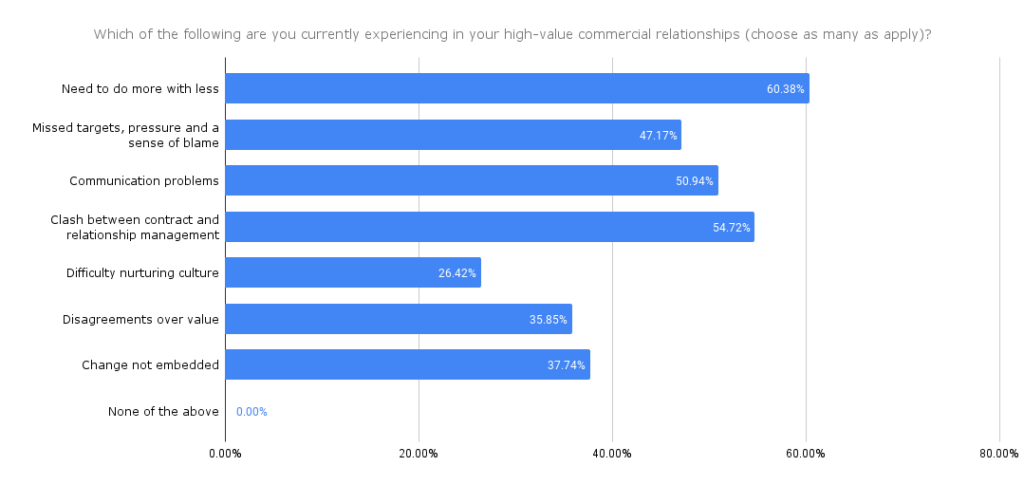
Only one symptom “scored” below 30% – hardly a low number in context – and all of the symptoms indicated issues with Things That Matter, e.g.:
- 60% of respondents under pressure to do more with less: what do they prioritize? What matters most?
- Over 50% feeling that contract management and relationship management clash: conflicting Things That Matter and, again, a question of what to prioritize.
- Over 50% reporting communication problems: there are likely operational factors involved, too, but we looked in the webinar at how a lack of clarity on the Things That Matter leads to mis-assumptions, misunderstandings, misalignment and missed opportunities – all of these involve communication!
Next, whilst it’s true that the selected symptoms were quite diverse – touching on resourcing, communication, culture, etc – it was still notable that everybody was experiencing at least one of them:
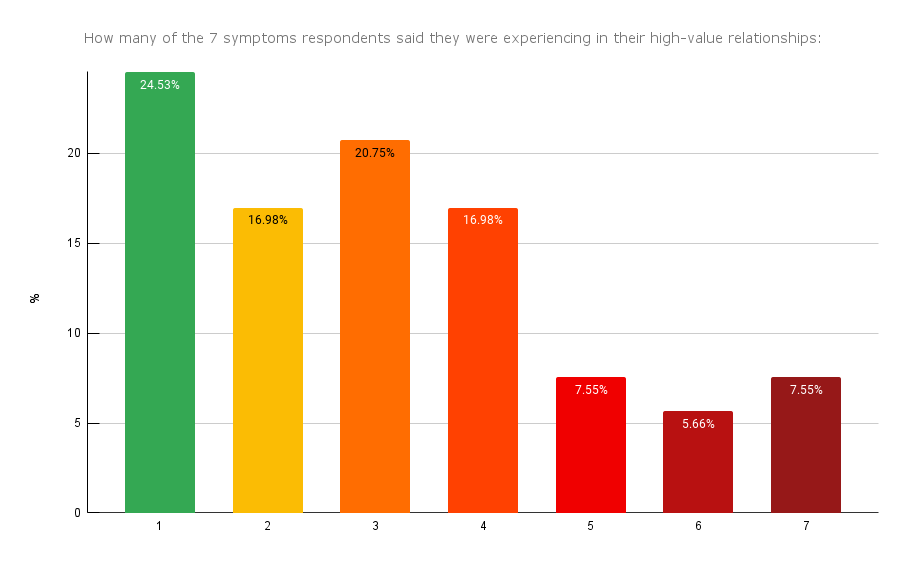
Indeed, almost 60% were reporting 3 or more of the 7 symptoms presented, and it’s very possible that – in the rush to complete the poll – some attendees didn’t realize they could select more than one symptom (which may explain the slight spike at the start of the chart).
As expected, this shows that people are typically experiencing multiple issues, and it therefore seems safe to make two observations:
- The Things That Matter really aren’t clear and aligned, and this is causing all kinds of issues: again, now not “just” something we claim, but evidenced on the ground.
- The symptoms in the Symptoms of What’s Not Working diagnostic absolutely pinpoint relevant areas, validating why we typically start with it.
As before, the attendees are to be commended for their frankness, but also reassured – what they’re saying absolutely reflect what we’re seeing everywhere (or we wouldn’t have been able to develop the diagnostic); they were also presented with an alternative that works.
And that puts them (and WorldCC more generally) ahead of most others out there, because this isn’t where the story needs to end – there’s a way to turn the situation round.
In Conclusion
That’s a story for another time – you can find it throughout the other pages and articles on this site – but it starts with people honestly looking at what they’re currently doing, and honestly facing what that’s leading to.
That’s exactly what last week’s webinar attendees did, and they saw that:
- Confidence is low that those involved in relationships are clear and aligned on what matters.
- The Things That Matter are at best dispersed across multiple places – fragmenting focus – and crucial subjective Things That Matter are not adequately covered.
- The resulting experience on the ground is very difficult (which is putting it mildly!).
And so what’s the state of the union when it comes to Things That Matter? Dis-union.
Isn’t it time that something was done about that?

